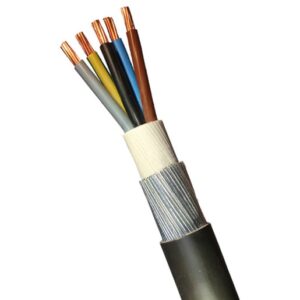SWA Information Sheet
What is SWA armoured cable?
SWA Armoured cable is the name given to any electrical cable constructed with a layer of aluminium wire armour or steel wire armour. The armour sits below the sheath of the cable to provide protection for the conductor and insulating layers.
Why is SWA cable armoured?
When an electrical cable is required for use outside or in direct burial projects, it must have mechanical protection. Aluminium wire armour or AWA, and steel wire armour or SWA, provide such protection – as well as enabling the cable to withstand higher pulling loads.
What types of SWA armoured cables are there?
AWA and SWA are used in the following power cables:
SWA Cable – PVC
Steel Wire Armoured Cable or SWA Cable, is a hard-wearing mains electricity cable with class 2 stranded copper conductors, XLPE (Cross-Linked Polyethylene) insulation, PVC (Polyvinyl Chloride) bedding, aluminium or steel wire armour and a black PVC sheath. SWA Cable is sometimes referred to as Booklet Armoured Cable, Mains or Power Cable. The voltage rating of an SWA Cable is 600/1000V.
SWA Cable – LS0H
The low smoke zero halogen or LS0H, version of SWA Cable is constructed in exactly the same way as the PVC SWA Cable – with copper conductors, XLPE insulation and aluminium or steel wire armour. The only difference is that LS0H SWA Cable has LS0H bedding and an LS0H sheath. LS0H SWA Cable is used in public areas because the sheath only emits very low levels of smoke and non-toxic levels of halogen gas when exposed to fire (usually under 0.5% HCl emission).
11kV Cable – PVC
11kV SWA Cable is a power cable with armouring and a series of screens. Its class 2 stranded plain copper conductors are surrounded by a conductor screen made of semi-conducting material. This screen is then covered with a layer of XLPE insulation and an insulation screen – also made up of a semi-conducting material. Between the insulation and armour, 11kV Cable has a copper tape metallic screen, a PETP (Polyethylene Terephthalate) filler, binding tape separator and PVC bedding. A layer of aluminium or steel wire armour sits over the bedding – covered by a red or black PVC sheath. The voltage rating of an 11kV Cable is 6350/11000V.
11kV Cable – LS0H
The low smoke zero halogen 11kV Cable has the same number – and type – of layers as the PVC version. For the 11kV Cable to be used in public areas it must have LS0H bedding and an LS0H sheath.
33kV Cable
33kV Cable is made up of the same individual layers as a PVC 11kV Cable. The only difference is that the voltage rating on a 33kV Cable is 19000/33000V.
With which British Standards do SWA armoured cables comply?
Where SWA Cable is concerned, BS5467 and BS6724 are the British Standards that specify requirements for construction, and describe methods of testing for thermosetting insulated, armoured cables with rated voltages of 600/1000V and 1900/3300V. BS6724 applies to those cables that produce lower levels of smoke and corrosive products when exposed to fire in specified tests.
Both 11kV Cable (PVC) and 33kV Cable comply with BS6622, whereas 11kV Cable (LS0H) meets the requirements of BS7835. The BS6622 and BS7835 standards look at the specifications and test methods for the construction, dimensions and mechanical and electrical properties of thermosetting insulated, armoured cables with voltage ratings of 3800/6600V up to 19000/33000V.
All SWA armoured cables related to these standards are used in fixed installations in industrial areas and buildings.
What is the difference between AWA and SWA?
A single core armoured cable will always have a layer of aluminium wire armour (AWA) instead of steel wire armour (SWA). This is because the steel in SWA has a much lower conductivity – and therefore higher resistance – than aluminium. If it were used in a single core cable the magnetic field generated would induce an electric current in the armour (eddy current) and – combined with the increased resistance – would have a heating effect. AWA is non-magnetic and has a much better conductivity (lower resistance), so can conduct these induced currents to earth more efficiently than steel. SWA is used in multicore armoured cables because the electromagnetic fields from the neighbouring cores effectively cancel each other out, meaning less current is induced into the armour.
What industries use SWA armoured cables?
You’ll find armoured cables in everything from transmission, power and distribution networks and the renewable energy sector to the oil, gas and petrochemical, water treatment and transport industries. In railway networks, for example, SWA Cable supplies power to those areas not listed as trackside and 33kV and 11kV Cables distribute power between substations (33kV is used over longer distances).
Cable sizes and some specifications
- Application:
- SWA Cable – power and auxiliary control cables for use in power networks, underground, outdoor and indoor applications and for use in cable ducting.
- Standards:
- BS5467, IEC 60502
- Conductor:
- Class 2 stranded plain copper conductor to BS EN 60228:2005 (previously BS6360)
- Insulation:
- XLPE (Cross-Linked Polyethylene)
- Bedding:
- PVC (Polyvinyl Chloride)
- Armouring:
- Single Core: AWA (Aluminium Wire Armour)
Multi Core: SWA (Steel Wire Armour) - Sheath:
- PVC (Polyvinyl Chloride)
- Sheath Colour:
- Black
- Voltage Rating:
- 600/1000V
- Temperature Rating:
- 0°C to +90°C
- Minimum Bending Radius:
- 1.5mm² – 16mm²:
6 x overall diameter25mm² and above:
8 x overall diameter - Core Identification:
- 1 Core: Brown
2 Cores: Brown, Blue
3 Cores: Brown, Black, Grey
4 Cores: Blue, Brown, Black, Grey;
5 Cores: Green/Yellow, Blue, Brown, Black, Grey
Alternative core identification: White Cores with Black numbers -
Shop our huge range of SWA Cable





